Optinyte™ Technology

Optinyte™ technology is the brand name used for products that contain Nitrapyrin as the nitrogen stabilizer and Corteva Agriscience formulation technology. This proprietary and highly effective nitrogen stabilizer is the technology in wellknown products including N-Serve™ and eNtrench™. Products containing Optinyte technology can be used with pre-plant, at-plant and in-crop applications of nitrogen fertilizer and used with liquid manure, bio-slurry, and granular fertilizers such as urea and NPK, ammonium nitrate or liquid forms of nitrogen fertilizer, such as 28% or 32% UAN. Products with Optinyte technology have shown agronomic, economic and environmental benefits when utilized in a wide range of crops including: corn (maize), wheat, canola (oilseed rape), cotton, rice, sugarcane, tree nuts and vegetables. Formulations containing Optinyte technology are currently approved for use in over 25 countries
N-Serve™ with Optinyte™ technology is a proven nitrogen management tool that provides farmers with the rules of the Nitrates Directive. Optinyte technology has been shown to maximize the yield potential of their crop while reducing nitrogen leaching and reducing greenhouse
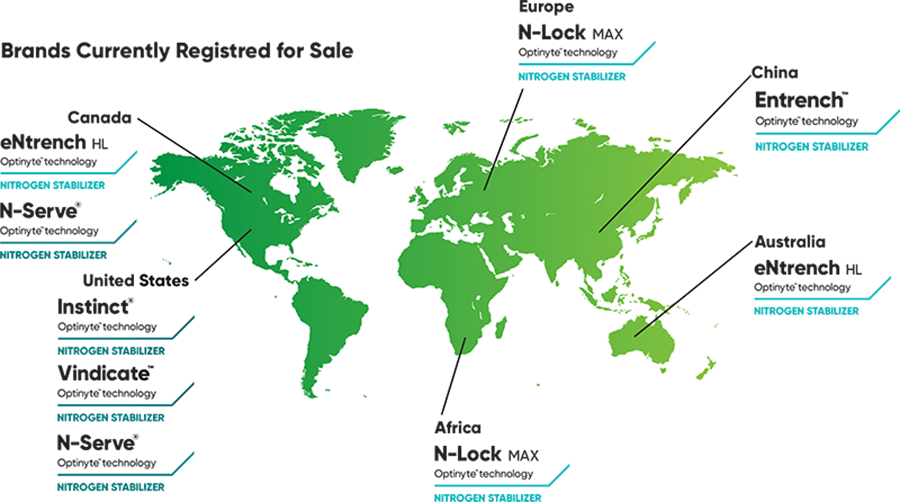
Nitrogen stabilizers with Optinyte™ technology slow the nitrification process in soils by inhibiting ammonia monooxygenase, an enzyme found in Nitrosomonas bacteria that catalyzes and an important step in the conversion of ammonium into nitrate. As a result, the growth rate of Nitrosomonas bacteria and the associated ammonium metabolism is reduced. Thus the soil nitrogen is stabilized; it remains in the protected ammonium form in the root zone for a longer period of time allowing for better crop utilization as opposed to being lost into groundwater through leaching or the atmosphere through denitrification.
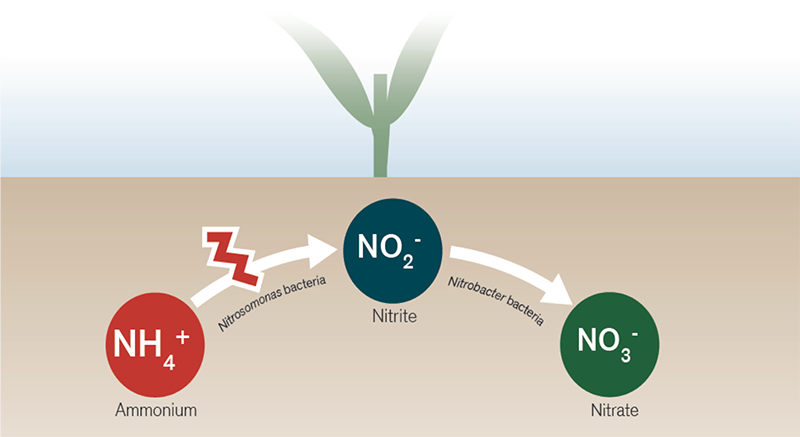
Corteva Agriscience nitrogen stabilizers, with Optinyte™ technology, are proven to protect nitrogen fertilizer which benefits both the environment and the crop. The environmental and agronomic benefits of Optinyte technology are documented in many peer-reviewed scientific publications and supported by more than 40 years of on-farm use. A foundational study published in 2004 (Wolt) summarized the benefits of Optinyte technology, through a meta-analysis. The study was based on published data from 186 field trials primarily conducted in US corn (maize) but also included data from other crops and geographies. Conclusions from this meta-analysis were that, on average, use of Optinyte technology resulted in a 51% reduction of nitrous oxide (N2O) emissions and a 16% decrease in soil nitrogen leaching. The stabilization of nitrogen resulted in a 7% increase in crop yield. These results were confirmed in a second meta-analysis published in 2015 (Qiao). In this study, the authors collected data from peer-reviewed studies published between 1984 and 2013 covering many geographies and crops including barley, corn (maize), pasture grass, rice, vegetables, and wheat. In addition to confirming the environmental benefits, the Qiao meta-analysis demonstrated using a nitrification inhibitor increased farmer revenue by approximately 8.95% even after accounting for the cost of using the nitrification inhibitor. Qiao concluded, “Our findings showed that nitrification inhibitors could create a win-win scenario that reduces the negative impact of nitrogen leaching and greenhouse gas production, while increasing the agricultural output.”
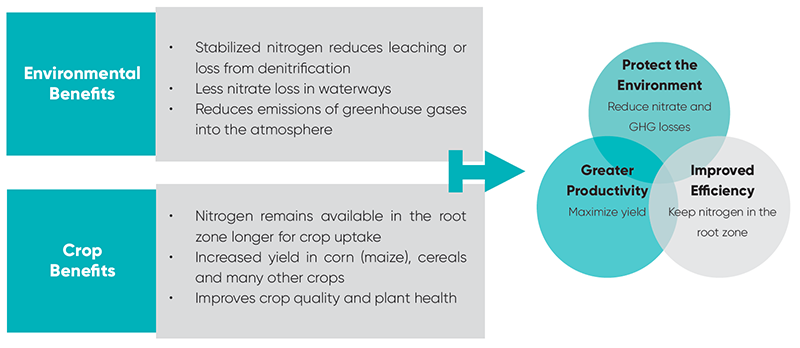
Furthermore, as an example of its ongoing commitment to sustainable chemistry, Dow AgroSciences reported life-cycle assessments (LCA) for Optinyte™ in Australian wheat farming and corn farming in the United States. These LCAs were holistic approaches to examining impacts over the complete life cycle of the product. In addition, the Optinyte LCA for corn farming was peer reviewed following ISO standards 14010 and 14044. The LCA results showed that potential benefits of using Optinyte far exceed the potential burdens created by its supply. Specifically the LCAs reported an 11-32% average reduction in life-cycle greenhouse gas emissions based on county and national data, with and without irrigation and drying. In addition, both assessments indicated that a reduction of marine eutrophication potential was a likely result of employing Optinyte technology in these systems.
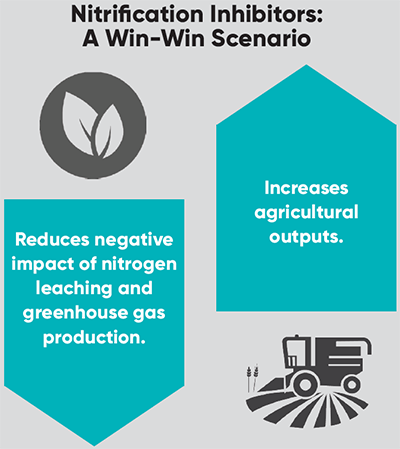
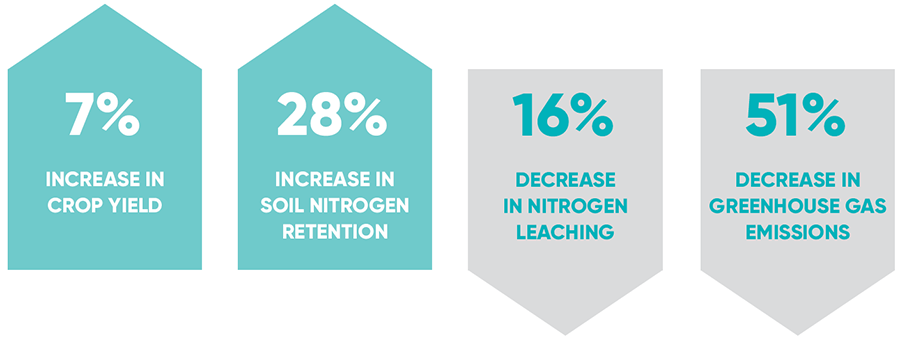
Scientists and advocacy groups continue to urge governments to enact regulations for better nitrogen management. Optinyte™ technology can enable more efficient use of nitrogen fertilizer, stabilizing it in the root zone where it can be utilized by the crop during important growth periods and reducing its movement to ground water and the atmosphere.
In 2016, Dow AgroSciences was awarded the prestigious U.S. Environmental Protection Agency (EPA) Presidential Green Chemistry Challenge Award for Instinct® nitrogen stabilizer with Optinyte™ technology. This is the fifth time Dow AgroSciences has been recognized with the EPA Green Chemistry Award, more than any other agricultural company. This illustrates the company’s focus and commitment to advance products that address pressing challenges in a sustainable way.
Optinyte technology is one tool that is being recommended and utilized to minimize the potential environmental contamination from nitrogen fertilizers. For example, in 2013, the Iowa Department of Agriculture implemented a Water Quality Initiative encouraging growers to use nitrogen stabilizers with Optinyte Technology to reduce nitrogen losses. The Iowa Nutrient Reduction Strategy is a science and technology-based approach to assess and reduce nutrients delivered to Iowa waterways and the Gulf of Mexico. The scientific assessment to evaluate and model the effects of nitrogen fertilizer use practices was developed through the efforts of 23 individuals representing five agencies or organizations, including scientists from Iowa State University, Iowa Department of Agriculture and Land Stewardship, Department of Natural Resources, United States Department of Agriculture Research Service and Natural Resources Conservation Service. The only nitrogen fertilizer practice that had both yield and environmental benefits was use of a nitrification inhibitor product with Optinyte technology.
In 2017, Dow AgroSciences was given the Iowa Water Quality Initiative Award. With this award, Dow AgroSciences was recognized for its focus on the importance of environmental stewardship and fertilizer efficiency. By providing technologies such as N-Serve™ and eNtrench™ nitrogen stabilizers with Optinyte technology, farmers can achieve strong yield in a way that helps protect the environment. eNtrench and N-Serve keep more nitrogen available in the root zone for crops to use, which reduces the escape of nitrates into groundwater and greenhouse gases into the atmosphere. In addition, the US EPA cites that nitrification inhibitors (e.g., Optinyte technology) as the most effective tool for reducing the emissions of the greenhouse gas nitrous oxide from agricultural cropland and more effective than lower nitrogen rates, split applications or minimum tillage (United States EPA - 430-R-06-005).
“Dow AgroSciences is honored to receive the State Secretary’s Ag Leader Award and proud to support the state of Iowa’s efforts to implement a science-based program to improve water quality,” says Eric Scherder, PhD, field scientist, Dow AgroSciences. “We look forward to continuing our support of a voluntary approach to nutrient stewardship that provides growers with tools that support environmentally beneficial farming practices while maximizing yield opportunity.”
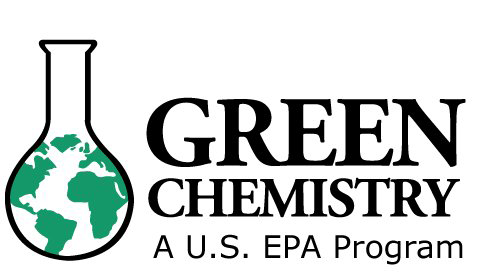
Presidential Green Chemistry Challenge: 2016 Greener Reaction Conditions AwardInstinct® Technology - Making Nitrogen Fertilizers Work More Effectively for Farmers and the Planet
In 2014 this technology: added about 50 million bu. of additional corn, equating to over $205 million in additional production revenue for U.S. corn growers; and reduced |
A collaborative study between Dow AgroSciences and the University of Bologna evaluated Optinyte™ technology in a European environment for the management of livestock manure used as a crop fertilizer (data not published). They compared the degree of nitrification and nitrogen leaching observed in soils treated with mixtures of Optinyte and cattle manure, pig manure or inorganic fertilizers. The study demonstrated the potential of Optinyte to reduce nitrification and nitrate leaching irrespective of the source of nitrogen providing both environmental and economic advantages. Optinyte technology clearly aligned to the Best Management practices mandated by the Nitrates Directive of 1991.
Optinyte technology was awarded the Hungarian New Product Award.
The Australian and Queensland governments announced a significant investment to support on-farm trials to evaluate nitrogen fertilizer technologies within sugar cane growing regions that flow to the Great Barrier Reef. Improving nitrogen use efficiency is a high priority to deliver significant reductions in nitrogen lost to waterways and the Great Barrier Reef lagoon. Nitrogen stabilizers with Optinyte™ technology are part of the next generation of fertilizer management tools that can increase farmer profit margins through improving yields, while at the same time benefiting the Great Barrier Reef by reducing fertilizer run-off and thereby improving water quality.
The Future of Optinyte™ technologyOver its 40-year life, Optinyte has been tested extensively around the world by private companies, independent research institutions and universities. Positive results have been widely published in peer scientific journals; over 200 studies have been published to date. Corteva Agriscience continues to conduct and support research with nitrogen stabilizers that contain Optinyte™ technology as use expands into new countries and new crops. Research is focused on characterizing the agronomic, economic, and environmental benefits of nitrogen stabilization. |
"The products described in this brochure are required to be registered prior to distribution or sale in many countries throughout the world. In some such countries or their political subdivisions, these products are not registered for sale or use. Contact the applicable regulatory authority for your jurisdiction to determine if a product is required to be registered, and if so, if it is registered for sale or use in your national, state or local jurisdiction. Always read and follow label directions. The Information and recommendations in this brochure are presented in good faith and for general information only. The Information is believed to be correct as of the date presented. However, neither Corteva Agriscience LLC nor any of its related companies makes any representation or warranty as to the completeness or accuracy of any of the Information. The reader assumes the entire risk of relying on the Information. The Information is supplied on the condition that the reader or any other person receiving the Information will make their own determination as to its suitability for any purpose prior to any use ofthe Information. In no event will Dow AgroSciences LLC or its related companies be responsible for damages of any nature whatsoever resulting from the use of or reliance upon the Information or any product referred to in the Information."
"The Information is not to be construed as a recommendation to use the Information, product, process, equipment or formulation that conflicts with any patent, copyright or trademark, and neither Corteva Agriscience LLC nor any of its related companies makes any representation or warranty, express or implied, that any use of the Information will not infringe on any patent, copyright or trademark. Nothing contained herein shall be construed as conferring by implication, estoppel or otherwise any license or right under any patent, trademark or copyright of Dow AgroSciences LLC or any third party."
"THIS INFORMATION IS PROVIDED “AS IS” AND NO REPRESENTATIONS OR WARRANTIES, EITHER EXPRESS OR IMPLIED, OF MERCHANTABILITY, FITNESS FOR A PARTICULAR PURPOSE OR OF ANY"
"OTHER NATURE ARE MADE WITH RESPECT TO THIS INFORMATION OR TO ANY PRODUCT REFERRED TO IN THIS INFORMATION."
"“™ ® Trademarks of Corteva Agriscience and its affiliated companies. © 2022 Corteva."